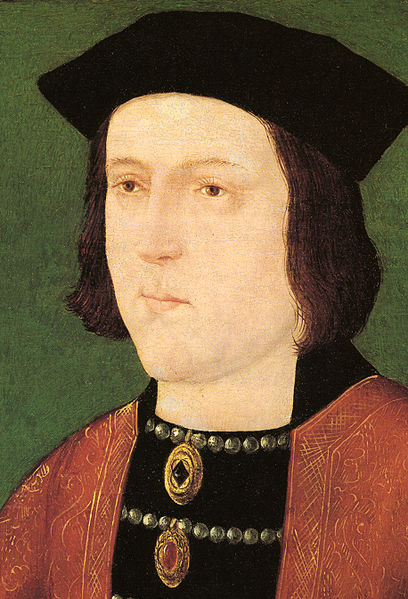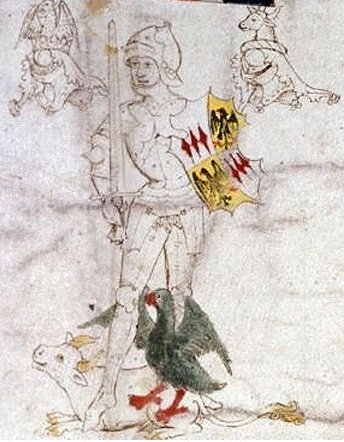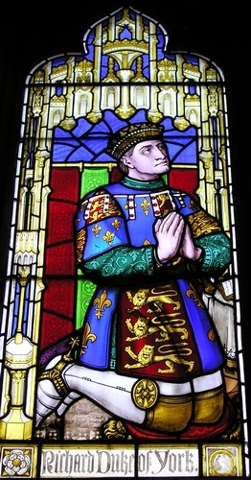In many ways, Elizabeth of York is one of the most pivotal, and yet elusive, figures in the Wars of the Roses. Her agreement to marry Henry VII cinched his kingship. Yet, despite several excellent books about Elizabeth, she remains enigmatic. Who was she really? A haughty young princess desperate to be queen even if the cost was marrying an uncle who may have murdered her brothers? The “humble and reverent” wife of Henry VII? A hard-nosed survivor willing to sacrifice her own happiness so her sisters would have a chance at decent marriages? The sensual, amoral, incestuous lover of Richard III or Henry VIII’s loving mother?
At a 500-year remove, in an age that seldom recorded women’s lives, her character remains elusive. It’s hard to separate the flattering and politically aware descriptions ambassadors and contemporaries made about Elizabeth of York from the private woman. While chroniclers were not above obliquely criticizing queens, the most that we can assuredly ascertain from many of their remarks is that she was close to her family and relatively inoffensive — or shrewd enough not to reveal her true feelings. The portrait that comes down to us is, in some ways, the stock portrait of many medieval queens: kind, charitable, selfless, and loving — the ideal queen.
Yet most medieval nobles were not necessarily renowned for being loving and kind. Hugh Trevor-Roper once cynically remarked, “Why must the tomb be prefabricated, the masses prepaid? It is because, in spite of all this lip service to family, nobody really trusted anyone else, not even his sons, once his power over them was gone. In reality the family was not cultivated as such: it was a necessary alliance from which every man hoped individually to profit.” 1
Today many of us believe that the proverbial apple doesn’t fall far from the tree, and neither of Elizabeth’s parents hesitated to exercise power. Elizabeth was raised to be a queen, addressed as the dauphine, and, as the eldest, privileged beyond all her other siblings, except maybe her brothers. It pushes credulity to believe that Elizabeth would grow up to be kind and humble despite all childhood indications that she would be as power hungry as her family or contemporaries – unless, of course, something changed.
Elizabeth’s childhood vacillated between privilege and anxiety. Perhaps, after her father’s death, anxiety ultimately overrode what might have been a tendency towards arrogance.
Earliest memories
Elizabeth’s earliest memories were likely of days that showcased the splendor of her family’s position punctuated by moments of fear, anxiety and grief.

Elizabeth’s first memories might have been fleeing for her life during the Readeption period, being urgently rowed down the Thames under a cloak of darkness, and sheltering in the Tower from Warwick’s forces. The thunder of men marching, the clash of metal swords, screams, and fires may have been other terrifying memories of those days. 2
After her father reclaimed the throne, Elizabeth’s life may have calmed down and returned to a period of normalcy. Still, like most medieval children, grief punctuated her early days. Shortly afterward in 1472, when Elizabeth was six, her maternal grandmother Jacquetta Woodville died. Later that year in December, Elizabeth’s eight-month-old baby sister Margaret died. In spite of these deaths, in the early 1470s, Elizabeth’s family’s life was getting back on track.
Certainly her father’s glorious building and remodeling campaigns, notably Windsor, fueled from the splendors he saw during his Burgundian exile, must have led Elizabeth to feel as though she and her family sat on the edge of a momentous rebirth for England – a hopeful and dazzling time indeed. It would be hard for Elizabeth to escape the impression that she and her family were special, set apart – the creators of a new era for England.
In 1475, however, anxiety may have visited her once more when her father went off to war with France. Presumably, nine-year-old Elizabeth would have felt nervous and vulnerable that her father could die. Edward took the possibility of death so seriously he wrote a detailed will before he left. Only a few months would pass before the pendulum would swing the other way.
When Edward returned from war, Elizabeth’s life took an exciting turn. Around late August 1475, the war with France was over and Edward betrothed Elizabeth to Dauphin Charles, the five-year old heir of King Louis XI. Elizabeth was dressed in the French style, was treated like a queen-in-waiting, and greeted as “Madame la Dauphine.” Elizabeth’s education now changed to prepare her for her new role. Her instructors emphasized court protocol and ritual. She learned French.
But, even before her great match to the French king’s son, she knew to expect a great future.
A Wedding to Aspire To?

When Elizabeth was two years old, her father arranged, without exaggeration, the wedding of the century between his sister Margaret and the insanely wealthy Charles, Duke of Burgundy.
Because Bruges was the cloth-trading capital of Western Europe and the wedding a vehicle for Charles to display his massive wealth, seemingly every gathering place, feast hall, horse, was decorated in insanely expensive cloth ranging from velvet damask to cloth-of-gold. The only wedding today that would barely rival it would be that of Vanisha Mittal and Amit Bhatia, a $70 million six-day extravaganza held at Versailles in 2004.
Charles spent 56,000 livres (roughly $540,164,337USD or £331,400,000GBP in today’s wages) on textiles from one cloth merchant alone. 3 Charles own crimson cloth of gold gown for the first tournament after the ceremony was sable lined. The fabric alone cost 1,488 livres. 4 To put these sums in perspective, a master stone mason made just a little bit more than the price of 27 inches of cloth-of-gold. 5
The unheard of expense stunned the English party who accompanied Margaret. Although it is unlikely Elizabeth would remember the wedding preparations, she probably heard tales of the wedding for years. Given that Elizabeth’s father arranged this union, she likely expected to marry a king or duke just as grand—even as a little girl.

Elizabeth’s Marriage Prospects
“Her purpose from birth had been to supply the needed alliance through marriage. She may have been a princess, may have carried royal blood in her veins, but she was to be bought and sold to the most important bidder.”— Nancy Lenz Harvey, one of Elizabeth of York’s biographers, describing her subject

Elizabeth’s marriage prospects and future career flip-flopped as Edward’s strategies changed and his enemies needed appeasement. As Alison Weir shrewdly observes, by the time Elizabeth was eight, she had already been offered up for marriage to Edward’s enemies three times.
In 1470, while Edward was attempting to regain his throne after Warwick revolted, he proposed Elizabeth marry Warwick’s nephew, George Neville, Duke of Bedford. Edward did this to provide an outlet for Warwick’s ambitions by letting him hope his heir would be king someday. After Warwick died, Edward threw out this betrothal. And, by the mid 1470s, Elizabeth was set to marry the French Dauphin.
After 1475, her parents’ main preoccupation was arranging great marriages for all their children. This occupied Elizabeth’s father continuously. Brilliant matches for such a large brood could immortalize Edward IV’s dynasty and create a network of royal kin to rival that of the Holy Roman Emperor ((See Charles Ross Edward IV p. 245.)). Edward, however, likely found the Yorkist marriage prospects and negotiations to be a little tricky. Not only would continental royalty see Edward IV’s dynasty as relatively new and unstable, Edward lacked the money to fund six dowries sufficiently.
The Late 1470s

In spite of the dizzy whirlwind of marriage prospects and the glories of Edward’s building campaigns, the little girl who was now the pre-eminent princess of her realm, still experienced her share of grief.
In 1476, Elizabeth received a new sister, Anne of York. Within a few months, however, the baby’s namesake and Edward IV’s sister, died in childbirth. Quite possibly this cast a gloom over Elizabeth’s father if not her entire family. Two years Edward’s senior, Anne may have been the sister Edward saw and maybe even indulged the most. Edward ignored Anne’s scandalous lifestyle – she lived adulterously with a man for years. Edward employed her lover as his esquire of the body and gave him enormous endowments. Unlike Edward’s other sisters, he probably saw Anne frequently because her lover and (eventual husband) had a position in Edward’s chamber.

Despite Anne’s death, the summer of 1476 gave the Yorks catharsis. Edward had Elizabeth’s grandfather, Richard of York, and her uncle, Edmund of Rutland, reburied with an exceptionally elaborate funeral processional.
In 1460, when the Lancastrians had killed Richard of York, they mocked his claim to the throne by putting his head on gates of the City of York with a mocking paper crown, an act that desecrated his body.
Now that Edward finally had a stable, solvent realm, he moved his father and brother’s bodies across country to Fotheringhay amidst tremendous pomp. Elizabeth attended the ritualistic High Mass (funeral rites).
Perhaps, Elizabeth’s family saw the reburial as the final closure to a terrible chapter and visible symbol of the dynasty’s stability. Little did they know what lay ahead.
An Uncle Dies
The next year, 1477, Elizabeth’s uncle George (Duke of Clarence) re-emerged as a threat to her father’s rule.

Even before his arrest, Clarence may have been an uncomfortable presence when Elizabeth saw him at feasts and other gatherings. The duke sometimes refused to eat or drink at the king’s banquets; Clarence would announce his food was poisoned. Such erratic behavior might have disturbed the young girl.
By the time Clarence was arrested in June 1477, Elizabeth would have been eleven. It is impossible to know what Elizabeth may have been told about her uncle’s activities or death. Did she only hear whispers from servants? Did her mother or father formally announce Clarence threatened Edward’s life once more? Presumably, at a minimum, she would have been told her uncle was a traitor to the realm. Did such close betrayal unsettle her? Did Clarence’s arrest reinforce the precariousness of her family’s position and, ultimately, their safety? It is hard to know.
Clarence’s trial and execution must have caused a strange family tension and dynamic since her father arranged it to coincide with his younger son’s wedding to Anne of Mowbray. Later on, Elizabeth’s father deeply regretted his brother’s death. Did Edward’s guilty conscience accelerate his descent into excessive eating and drinking? This is unrecorded. Likewise, nobody knows if his guilt manifested itself in a darker mood that trickled over into his family life.
Annus Horribilis: 1483
Ultimately, by the time Elizabeth was eighteen, Fortune’s Wheel had completely upended her once promising future. Louis XI backed out of the marriage agreement between Elizabeth and the dauphin. Her father died. Her brothers disappeared. And, Elizabeth was living once again in sanctuary. At that point, her marriage prospects vanished. Elizabeth had gone from being the prima princess to a noble daughter without a dowry. Later, Richard III would humiliate her and she would emerge as the humble and reverent wife of Henry VII.
Was Elizabeth a haughty and spoiled princess? Did she change from a haughty expectant Mme. la Dauphine to a humble young woman after her traumatic stay in the sanctuary? Was she ever haughty in the first place? Did her mother-in-law, Margaret Beaufort, humble her? The only contemporary account that corroborates this perspective is that of the Spanish ambassador who states that Margaret “kept [Elizabeth] in subjection” – an account some historians have dismissed.
Ultimately, Elizabeth of York is a cypher but one who died triumphantly by her day’s standards for medieval queens.
- H.R. Trevor-Roper “Up and Down in the Country: The Paston Letters” in Historical Essays (New York, 1966) p. 31 ↩
- See Amy Licence’s book Elizabeth of York: the Forgotten Tudor Queen, which provides an excellent, vivid description of the Readeption period and Warwick’s forces in London. ↩
- Conversion based on labor value on measuringworth.com, assumes livres to pounds equivalency, which may be incorrect. For information about the wedding fabric, see “The Role of Dress in the Image of Charles the Bold” by Margaret Scott on p. 51 in Flemish Manuscript Painting in Context: Recent Research ed. Elizabeth Morrison, Thomas Kren ↩
- At 48 livres per ell (~27 inches), this particular cloth of gold was extremely expensive – three times the standard cloth of gold, which cost 16 livres 16 sol per ell. This cloth was so extravagant and labor intensive, it had to be custom ordered. Ibid. ↩
- Ibid. ↩
